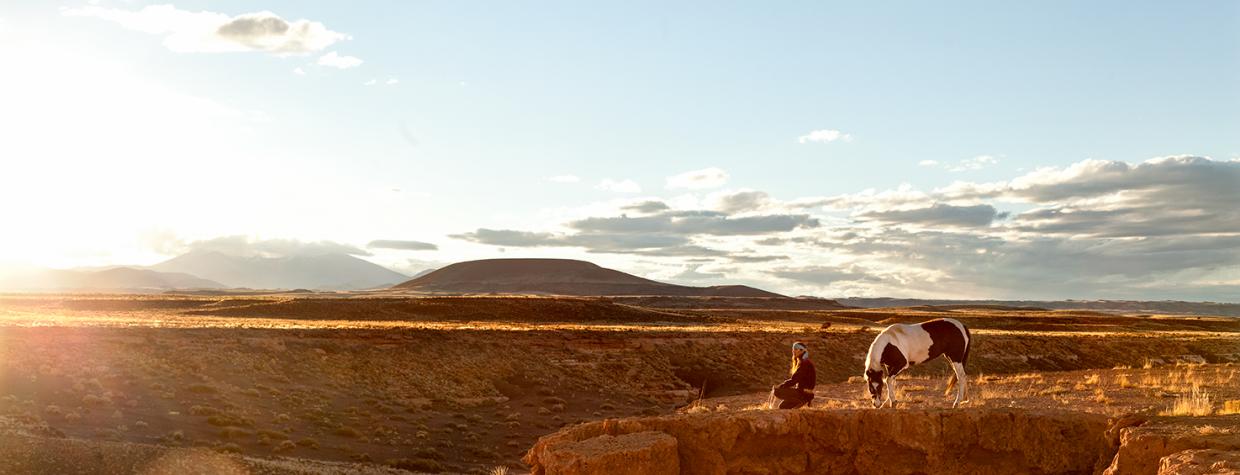The paint is stubborn. She wants to be approached no more than she wants to be ridden. Ears back. Head tossing. Blue eye burning. The other — brown as the mud after a drenching rain — stares at the man who’s come into her space.
He is lithe and patient where she is headstrong and boldly muscled. He nears her. She bolts, mushrooming dust. He waits. Again, he nears her. She stays. He turns. She follows. Stop. Start. Turn.
This is their pasodoble, the dance of the bull and matador translated to the horse and trainer, its cadence slowed and gentled to the pace of the man. The Navajo. The whisperer.
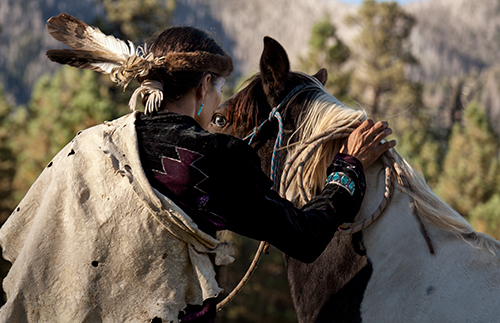
Clayson Benally is a horseman and a healer by birth, sprung from tradition and descended from the Navajo warriors who donned mountain lion, bear, eagle and owl caps and rode bareback across the desert. Benally believes deeply in the fragile beauty of man’s relationship to horses, both because of his work as a preservationist of traditional Navajo horse-training techniques and because of his ancient-warrior bloodline.
He saw a photo of the warriors once — a tiny image in a newspaper — and it ignited in him a deep sense of pride for the lessons he learned as a boy.
“From the time you’re a young man, there are certain abilities you’re recognized for,” Benally says. “You’re initiated into certain societies or ceremonies, and that’s how I was brought up. That doesn’t exist so much for the men in our culture anymore. The photo was beautiful to me, and I found it. It was a beautiful reminder of the things I learned from my father.”
When Benally was born, his extended family’s herd numbered 60 horses. If he wanted to claim one, he’d pick out the strongest, train it and let it roam free in the pasture. And when he wanted to ride it, he’d hop on its back, bare and saddleless. That horse would carry him home.
By the time he’d reached adolescence, his elders had recognized in Benally a deep connection to animals — so deep that his great-aunt (he refers to her as his grandmother), Roberta Blackgoat, gifted him her horse, Dzili.
Small and red, a fierce little bird of an animal — just as the translation of her name implies — Dzili made Benally and his father chase her 8 miles between the walls of Blue Canyon before they could trailer her.
“That was a pivotal moment for me,” Benally remembers. “My grandmother recognized a special connection that I had to the horses. It was like she was gifting me with a legacy.”
Once a rider in Buffalo Bill’s Wild West show and a stunt rider in Western films, Jones Benally, Clayson’s father, had taught his son to train horses, and Benally took to Dzili in his own way.
“The Western way, the Buffalo Bill way, is about breaking a horse — you starve it, you whip it, you beat it,” Benally says. “But if you’re riding a horse bareback, you’re working with it instead of against it. You can feel every movement. You can feel the muscles tense. If the horse is thinking something, you can sense it. That’s how you’re supposed to connect.”
For Benally, the first step in connecting with a horse is to breathe his breath into its nostrils. From there, the relationship blooms through patience, through the asking of permission — to approach the horse, to touch it, to ride it and, ultimately, to alter the horse’s energy from wild to tame.
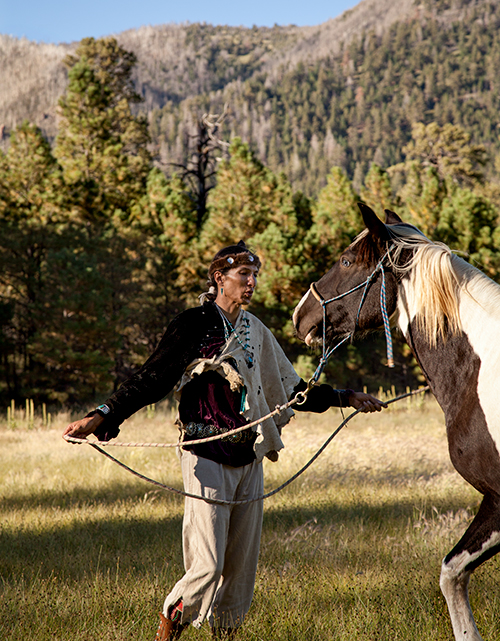
Indeed, Benally’s interaction with the paint — as it was with Dzili, and as it was with a horse named Somebody — is rooted in bonding, in trust.
At 41, Somebody is the patriarch of the herd, a seven-member pack that lives on the Benally homestead. The scrub-choked ranch in East Flagstaff is a hundred miles or more from the family’s ancestral home.
The horse is a glimpse of what Spotted Eagle, the paint, could be — if only she’d let Benally take the lead. Somebody is the first horse Benally ever worked with — before Dzili and the countless others into whose nostrils he’s exhaled.
Somebody once belonged to Hashk’aan, Benally’s grandfather, who, polio-stricken, used him as his primary means of transportation. One look at the horse and you see that he is spun from the stuff of his warrior ancestors, hobbled by age but graced by the wisdom that comes from ancient bloodlines, from having been hard-wired for survival.
When the saddle caught fire, it served as a warning.
Benally’s great-uncle and grandmother, Zonnie, were out surveying their sheep herd the moment it burst into flame. It happened spontaneously, the way meaningful things do, and Zonnie — a healer, too — had a vision.
“She checked and saw that a great sickness would sweep across the Navajo Nation,” Benally says. “The only way to survive was to stay away from the rest of the family, to stay with the sheep. The saddle caught fire as a means of telling them to butcher and eat the horse. That would give them the strength they needed to survive. They did. They stayed away for nearly two months. They returned, and the whole family had been wiped out.”
It was the influenza pandemic of 1918, and the horse was both a herald of sadness and a means of survival. That horse saved the Benallys.
Indeed, horses bear a certain sacred designation, both for the family and for the Navajo people. Used in ceremonies, they’re the symbols of that long-ago ethos of combat, of protecting land and crops and the traditions that long predate these United States.
According to some accounts — including Frank McNitt’s Navajo Wars: Military Campaigns, Slave Raids, and Reprisals — when the Spanish first encountered the Navajo people in the late 16th century, they came upon thousands of mounted warriors — men in traditional dress, wearing war bonnets — armed and waiting.
“Often, people don’t realize that is our own Diné identity, who we are as a people,” Benally says. “My dad has a war bonnet that was passed on from his grandfather.”
There were wars, of course. Raids. The Long Walk. The Spanish, the Mexicans, Kit Carson and Bosque Redondo. The angst-fueled pasodoble of people versus people.
And still, there were horses. So many, in fact, that hundreds of years after the mounted warriors met the Spanish, the federal government began implementing a systematic program of livestock reduction to address mounting problems with erosion — presumably from overgrazing — on the Navajo Nation.
During a meeting in Leupp in 1928, Assistant Commissioner of Indian Affairs E.B. Meritt told Navajo councilmen about “eventually limiting the number of sheep, horses, goats and cattle for any Indian so that benefits of the range may be more equitably distributed among all Navajo Indians.”
By late spring of 1931, a Senate subcommittee had convened to discuss the possibility of expanding the Navajo boundary, but with certain contingencies — among them the culling of the tribe’s herd of wild horses.
The Navajo people, though, believed that drought and insufficient acreage caused the erosion the feds were attempting to address. They asserted that, in time, Mother Nature would provide. Ultimately, the government mandated that the livestock load on the entire range be cut in half without delay. The Navajos’ widespread resistance so outraged government officials that it prompted one soil conservationist, W.G. McGinnies, to declare that there were “four different distinct infirmities which cause people to be opposed to stock reduction — ignorance, blindness, laziness and dishonesty.”
The boundary bill ultimately failed, but efforts to dwindle the number of horses and other livestock on the Navajo Nation have continued into the present.
And according to Benally, whose family has lost dozens of horses in the most recent round of livestock roundups, a lack of support isn’t a result of ignorance, blindness, laziness or dishonesty. The opposition is rooted in fiscal identity, as well as tradition.
“It’s interesting because with restrictions and different complications — these new government policies on the reservation — they’ve been sending horses off to slaughterhouses in Mexico,” he says. “Yes, horses are sacred to us, but they’re also part of what would be viewed as your bank account.
“The idea of restricting movement — the policies that have been enacted for our people — that’s really challenging,” he says. “There’s an idea of stewardship that’s always been part of our culture. You have summer camp and winter camp, and you allow the earth, the landscape, to heal in between. We recognize that animals — the deer, the elk, the sheep, livestock, horses, cattle — they’re life. They’re what sustain us. But there’s been a big disconnect recently.”
Indeed, since the Navajo-Hopi Land Settlement Act of 1974, which divided in half nearly 1.8 million acres of jointly owned Navajo and Hopi land in Northern Arizona and forced many Navajos to be relocated from their ancestral homeland, the people have had their homesteads significantly reduced. And, of course, just as there once were wars and raids, there were protests and benefit concerts.
Benally’s mother, Berta, a Greenwich Village-bred New Yorker, rallied her famous friends — among them Jackson Browne, Benal-
ly’s godfather — for a show. The family created a nonprofit organization to help protect livestock. And Roberta Blackgoat, the great-aunt who gifted Benally his first horse, became a symbol of Navajo defiance.
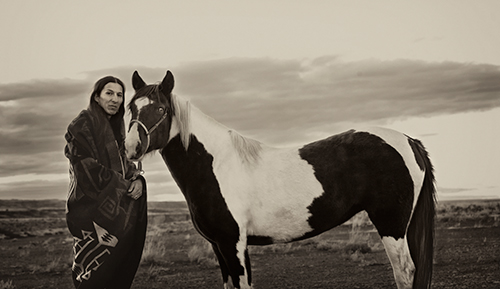
For Benally, Blackgoat was “the Geronimo of the era, the grandmother of the resistance.” Having grown up in Big Mountain, Black Mesa, she had gone to boarding school and learned English, which enabled her to translate when the government tried to remove her and others from their land.
“She resisted her whole life,” Benally says. “I grew up going to protests with her. Later, my siblings and I formed a band called Blackfire, and we started writing social and political songs.”
Ultimately, the protests failed, and the people who stayed in defiance of the law were later saddled with the Navajo-Hopi Land Dispute Settlement Act of 1996, which forced all remaining Navajos to sign leases with the Hopi Tribe that effectively terminated their property rights or subjected them to forcible eviction.
In June 1999, Blackgoat authored an open letter advocating for the reversal of the relocation process and voicing a response to the coal-mining claims that overtook the Navajo Nation. In part, it read:
“Great Spirit gave us this land to live in a good way. We’re not living here for free, everything we have, we have worked hard for. … All the natural resources that abound here are not here to be exploited but to be revered. All the things that we hold sacred have been co-modified. It’s co-modification of the sacred. We are given no respect as human beings, as to our existence.”
Few people who mattered listened, and the modifications continued.
Now, many Navajo homeowners contain their livestock to a 5-acre area. When the animals aren’t moving, they create overgrazing, erosion and other negative impacts on the land. So, the Navajo and federal governments are rounding up the horses and shipping them off once again.
And Clayson Benally is saving as many as he can.
The horses of the sun god ride in four colors: turquoise, pearl, red and coal. Born of the four sacred mountains and symbolic of the four directions, the horses determine the skies. When he begins his journey across the Earth from his hogan in the east, that sun god, Jo’hannaa’éí, chooses the turquoise or pearl horse for clear skies, the red or coal horse for storms, according to some accounts. Then he rides. East to west. Back again.
This is one legend of the Navajo. And on this day on the Benally ranch, the sun god has chosen a turquoise horse. The sky is the color of fresh water over travertine, the cool blue of midmorning, late summer. Of stillness. The horses, all rescues, are in their corrals, and the family has gathered to watch Benally and Spotted Eagle.
Benally can, he says, train a horse to do anything, and he has.
As an extra on the set of a made-for-television movie one winter, Benally found that the other actors who were hired to ride horses kept getting injured. The horses, mostly wild, would spook and throw the riders, and the entire scene was stressful. So Benally used what he had learned.
“For some films, I’ve had to train a horse to jump off a cliff,” he says. “You’re bareback at a dead run, jumping off with a bow and arrows in hand. You know it’s not real, but the horse doesn’t. To get to that level of trust and to have that level of communication, that’s amazing. That’s a lot of responsibility.”
The film work has been good — Benally has worked as an extra since he was a child — but the fulfillment he finds in helping others learn to work with their horses has been better. And he says it comes down to connection — physical and spiritual.
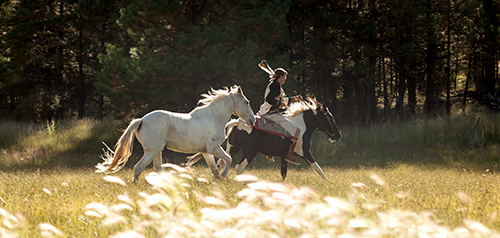
“I can hop up on someone else’s horse, and the horse will react totally different because I’m open and connected,” he says. “The horse is free. I allow it to have its head, its body, everything. The horse just opens up and it can run faster.”
Look at the angles of Benally’s face long enough, and you’ll believe that they’ve been shaped by the same winds that cut corners into the canyons of the Navajo Nation. They are sharp where he is soft, speaking to his 6-year-old daughter in the sweet, hushed tones of a man enamored. The girl, Bahiyyah, and Benally’s wife, Alethea, are patient with his passion: “He’s the most underpaid horse trainer and healer around,” Alethea says.
But the family knows payment isn’t the point of anything that Benally does.
“One of my goals is to use horses with anyone who has difficulties or challenges,” Benally says. “I put out the invitation: ‘Let’s go out for a horseback ride.’ There’s something in the horse itself, in the way it teaches, the way it connects. Horses see truth and understanding and things on a whole new level. There’s definitely a healing process when they interact with people.”
When he’s not with the horses, Benally helps his father — setting broken bones; visiting ailing elders; teaching people about traditional herbs and medicines; touring with his band, Sihasin. He’s gone, sometimes, for months at a time. But then he feels the pull back to Arizona, back to his family. Back to the horses.
Here in the corral with Spotted Eagle, Benally is home. The paint has startled again, but the cloud of dust has cleared. For a moment, both creatures are still. A heartbeat. Five. The pause in the pasodoble. Benally’s long fingers move over the animal’s flank. The man is relaxed. The horse is nearly there, but the muscles in her back legs are ready to fire, their lean wires pulled taut.
Spotted Eagle turns her head, and, for the first time this morning, the movement is toward her trainer.
In an instant, Benally is up. Bareback, saddleless. And there, in the corral, a hundred miles or more from his ancestral home, Clayson Benally is speaking to one horse in the ancient language of many.

